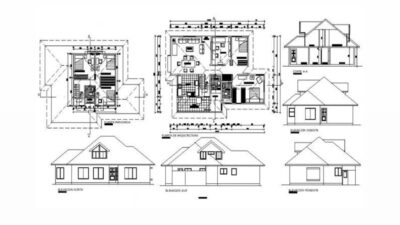Architecture is not just the art of building but a reflection of society’s evolution over centuries. This discipline has witnessed a myriad of changes, each style bringing its unique flavor to the panorama of design. From the awe-inspiring Gothic cathedrals to the sleek lines of Modernism, each architectural style is a mirror reflecting the technological, cultural, and artistic moods of its era. In this journey through 35 architectural styles, we explore the rich tapestry of designs that have left an indelible mark on our world.
A Guide to 35 Architectural Styles
- Contemporary Architecture: Characterized by unconventional forms, use of modern materials, and emphasis on sustainability;
- Victorian Architecture: Notable for its ornate detailing, drawing from Gothic revival and Italianate influences;
- Classical Architecture: Rooted in ancient Greek and Roman traditions, with emphasis on symmetry and grandeur;
- Vernacular Architecture: Focuses on local traditions and materials, often evolving faster than other styles;
- Modern Architectural Styles: Features minimalist aesthetics, functional design, and innovative use of new materials;
- Gothic Architectural Styles: Distinguished by pointed arches, ribbed vaults, and flying buttresses;
- Georgian Architecture: Known for its symmetry, classical proportions, and decorative elements;
- Art Deco Architectural Style: Combines modernist styles with fine craftsmanship and rich materials;
- Renaissance Architectural Styles: Revival of classical art and architecture with emphasis on symmetry, geometry, and proportion;
- Deconstructivism Architectural Styles: Characterized by fragmentation and non-linear processes of design;
- Byzantine Architecture: Features domes, rich mosaics, and an Eastern Orthodox influence;
- Brutalist Architecture: Utilizes raw concrete or brick, stark, geometric forms, and a utilitarian feel;
- Neoclassical Architecture: Inspired by the simplicity and grandeur of classical Greece and Rome;
- Gothic Revival Architectural Styles: Emphasizes medieval design elements, particularly pointed arches and elaborate ornamentation;
- Romanesque Architecture: Characterized by semi-circular arches, robust appearance, and thick walls;
- Bauhaus Architectural Style: Focuses on the harmony between function and design, with a minimalist approach;
- International Architecture Style: Known for its simplistic, functional structures often used in skyscrapers;
- Queen Anne Style Architecture: Features decorative excess, complex roof forms, and asymmetrical facades;
- Islamic Architecture: Includes large domes, minarets, and courtyards used in mosques and palaces;
- Expressionist Architecture: Emphasizes the emotional experience through unusual shapes and dynamic forms;
- Medieval Architecture: Encompasses a range of styles including Romanesque and Gothic;
- Greek Revival Architecture: Inspired by the architecture of ancient Greece, particularly its temples;
- Baroque Architecture: Known for its grandeur, rich colors, and dramatic use of light and shadow;
- Tudor Architecture: Features steeply pitched roofs, masonry chimneys, and decorative half-timbering;
- Beaux-Arts Architecture: Combines classical architectural forms with elaborate decoration;
- Italiante Architecture: Inspired by the villas of Italy, featuring tall windows and cupolas;
- Federal Architecture: Characterized by simplicity, symmetry, and an adherence to classical ideals;
- Neo-Futurism: Embraces technology and modern materials to create forward-looking designs;
- Colonial Architecture: Represents styles brought by colonists from their mother countries;
- Futurist Architecture: Emphasizes dynamism, speed, and technological innovation;
- Indo-Saracenic Architecture: A blend of Indian and Islamic architectural elements;
- Sustainable Architecture: Focuses on minimizing environmental impact and maximizing energy efficiency;
- Hawaiian Architecture: Integrates natural materials and open spaces to suit tropical environments;
- Rococo Architecture: Noted for its elaborate ornamentation, intricate scrolls, and pastel colors;
- Eclectic Architecture: A mix of various styles, often incorporating historical elements in new constructions.
The Start and Inspiration Behind Each Style
Each architectural style has its roots in the cultural, technological, and social fabric of its time. Contemporary architecture, for instance, emerged in the late 20th century as a reaction to the rigidity of modernism, emphasizing sustainability and innovative design. Gothic architecture, dating back to the mid-12th century, was a response to the perceived limitations of the Romanesque style, introducing new structural solutions like flying buttresses to create awe-inspiring religious buildings.
Contemporary to Gothic: A Deep Dive into Architectural Eras
This section takes a closer look at the evolution from Contemporary to Gothic styles. Contemporary architecture breaks from tradition to embrace unconventional forms and sustainability. In contrast, Gothic architecture, with its pointed arches and elaborate detailing, aimed to reach towards the heavens, symbolizing the era’s religious fervor.
From Renaissance to Modernism: Unraveling Architectural Evolution
The journey from the Renaissance, marked by a revival of classical ideas, to Modernism, which embraced functionality and new materials, is a testament to the ever-changing landscape of architectural thought. Renaissance architecture sought to bring back the symmetry and proportion of classical buildings, while Modernism represented a break from traditional forms, focusing on the needs of a rapidly industrializing world.
Comparative Table: Architectural Styles Across Eras
| Style | Era | Characteristics |
|---|---|---|
| Contemporary | Late 20th Century | Innovative, sustainable, non-traditional |
| Gothic | 12th-16th Century | Pointed arches, flying buttresses, religious symbolism |
| Renaissance | 14th-17th Century | Classical influence, symmetry, proportion |
| Modernism | Early 20th Century | Functionality, new materials, minimalism |
Key Bullet Points: Understanding Architectural Styles
- Innovation and Adaptation: Architectural styles evolve in response to societal changes and technological advancements;
- Cultural Reflection: Each style reflects the cultural and artistic trends of its era;
- Functionality vs. Aesthetics: Styles vary in their emphasis on functionality, aesthetics, or a blend of both;
- Historical Context: Understanding the historical context of each style provides deeper insights into its development and characteristics;
- Sustainability Focus: Contemporary architecture increasingly focuses on sustainability and environmental friendliness.
The Role of Technology in Evolving Architectural Styles
The advent of technology has played a pivotal role in shaping architectural styles. From the ancient use of simple tools to today’s sophisticated software, technology has continually expanded the boundaries of what is architecturally possible. In ancient times, the limitations of construction technology influenced the simplicity and functionality of structures. As technological advancements were made, architects began to experiment with more complex designs, such as the intricate Gothic cathedrals with their soaring spires and flying buttresses, made possible by advancements in structural engineering.
In the modern era, the introduction of materials like steel and concrete, along with computer-aided design (CAD) software, has revolutionized architectural design. Contemporary architecture demonstrates the impact of these technologies, with buildings showcasing innovative forms and unprecedented structural feats. Technology not only enables the creation of new styles but also aids in preserving and restoring historical structures, allowing for a deeper understanding and appreciation of architectural heritage.
The future of architectural styles is intrinsically linked to technological progression, promising even more groundbreaking designs and concepts.
Environmental Influences on Architectural Styles
Environmental factors have significantly influenced architectural styles throughout history. Geography, climate, and available materials have dictated the practical aspects of architectural design, leading to the development of distinct styles suited to particular environments. For example, vernacular architecture, which evolved as a response to local conditions, utilizes materials that are readily available in the environment, reflecting a practical approach to building that is inherently sustainable.
In hot and arid climates, traditional architectural styles often feature thick walls, small windows, and courtyards to regulate temperature and provide shade. In contrast, architecture in colder regions typically includes steeply pitched roofs and sturdy construction to withstand snow and wind. The growing awareness of climate change and environmental degradation has given rise to sustainable architecture, a style that prioritizes energy efficiency, the use of eco-friendly materials, and a minimal environmental footprint. This shift represents a profound understanding of the interconnectedness between the built environment and the natural world, driving architects to create designs that harmoniously coexist with their surroundings.
Socio-Political Factors Shaping Architectural Styles
Architectural styles are not only a reflection of artistic and technological advancements but also a product of socio-political contexts. Throughout history, architecture has served as a symbol of power, ideology, and social values. For instance, the grandeur and opulence of Baroque architecture were expressions of the wealth and power of the Catholic Church and the aristocracy in 17th-century Europe. Similarly, the minimalist and functional characteristics of Modernism emerged partly as a reaction to the ornate styles of the past, aligning with the modernist ethos of simplicity and social progress.
The socio-political environment can also influence the accessibility and affordability of architecture. For example, Brutalism emerged in the post-war era as a practical solution to the need for mass housing, reflecting a utilitarian approach aligned with socialist ideals. In contemporary times, issues such as urbanization, housing crises, and social inequality continue to influence architectural styles and practices, prompting architects to explore more inclusive, equitable, and community-oriented designs. Understanding the socio-political underpinnings of architectural styles provides a deeper insight into how buildings and spaces can shape and reflect societal values and aspirations.
The Essence of Architecture Practice: Bridging Theory and Reality
The practice of architecture transcends beyond the theoretical knowledge acquired in academic settings, encompassing a wide array of skills, responsibilities, and ethical considerations. In real-world practice, architects must balance artistic vision with practical constraints, such as budget limitations, client requirements, and regulatory compliance. The essence of architectural practice lies in the ability to translate conceptual designs into functional and aesthetically pleasing structures that meet the needs of users and contribute positively to the built environment.
Architecture practice involves continuous collaboration with various stakeholders, including engineers, contractors, urban planners, and clients. Effective communication and project management skills are crucial in coordinating these diverse teams and ensuring that projects are completed on time and within budget. Architects in practice also need to stay abreast of evolving building codes, environmental regulations, and technological advancements in construction and materials.
Moreover, ethical considerations play a significant role in architectural practice. Architects must make decisions that prioritize sustainability, public safety, and social responsibility. The choices made in design and construction can have lasting impacts on communities and the environment, emphasizing the architect’s role as a steward of the built landscape.
Conclusion
The study of architectural styles is a journey through the history of human civilization. Each style, from the grandeur of Classical architecture to the minimalism of Modernism, tells a story of societal values, technological progress, and artistic expression. Understanding these styles not only enriches our appreciation of the built environment but also prepares us to contribute to its future evolution.











